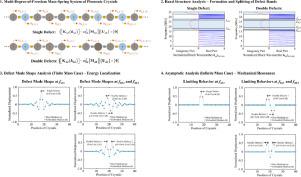International Journal of Mechanical Sciences ( IF 7.1 ) Pub Date : 2021-11-18 , DOI: 10.1016/j.ijmecsci.2021.106950 Soo-Ho Jo 1, 2 , Heonjun Yoon 3 , Yong Chang Shin 1 , Byeng D. Youn 1, 2, 4

|
Phononic crystals (PnCs) have received growing attention in recent years, due to their ability to manipulate elastic waves, such as in the case of defect-mode-enabled energy localization. Although previous studies have explored defect modes of PnCs – from phenomenon observations to their potential applications – little effort has been made to date to reveal fundamental mechanisms of defect-mode-enabled energy localization. Thus, this study proposes a lumped-parameter analytical model to reveal the underlying principles of the formation of defect bands of a one-dimensional PnC when a single defect is introduced, or the splitting of defect bands when double defects are introduced. Through the investigation of 1) evanescent wave characteristics in the defect-mode shapes, and 2) the asymptotically equivalent behaviors of defect bands and defect-mode shapes with limiting behavior approaches, this study demonstrates a new aspect of why a band gap should be the prerequisite for achieving defect-mode-enabled energy localization. It is confirmed that defect-mode shapes are normal modes, rather than propagating wave modes. The key findings of this study are as follows: 1) the exponentially attenuating characteristics of evanescent waves in a band gap generate a fixed-like boundary condition, which surrounds single or double defects, and 2) mechanical resonance, attributed to the fixed-like boundary condition, leads to the formation and splitting of defect bands.
中文翻译:

揭示一维声子晶体的缺陷模式启用能量定位机制
近年来,声子晶体 (PnC) 受到越来越多的关注,因为它们能够操纵弹性波,例如在启用缺陷模式的能量定位的情况下。尽管之前的研究已经探索了 PnCs 的缺陷模式——从现象观察到它们的潜在应用——但迄今为止几乎没有努力揭示缺陷模式启用的能量定位的基本机制。因此,本研究提出了一种集总参数分析模型,以揭示引入单个缺陷时一维 PnC 缺陷带形成的基本原理,或引入双缺陷时缺陷带分裂的基本原理。通过研究 1) 缺陷模式形状中的倏逝波特性,和 2) 缺陷带和缺陷模式形状的渐近等效行为与限制行为方法,这项研究展示了为什么带隙应该是实现缺陷模式启用能量定位的先决条件的新方面。已确认缺陷模式形状是正常模式,而不是传播波模式。本研究的主要发现如下:1) 带隙中倏逝波的指数衰减特性产生固定类边界条件,其围绕单缺陷或双缺陷,以及 2) 机械共振,归因于固定类边界条件,导致缺陷带的形成和分裂。这项研究展示了为什么带隙应该成为实现缺陷模式启用能量定位的先决条件的新方面。已确认缺陷模式形状是正常模式,而不是传播波模式。本研究的主要发现如下:1) 带隙中倏逝波的指数衰减特性产生固定类边界条件,其围绕单缺陷或双缺陷,以及 2) 机械共振,归因于固定类边界条件,导致缺陷带的形成和分裂。这项研究展示了为什么带隙应该是实现缺陷模式启用能量定位的先决条件的新方面。已确认缺陷模式形状是正常模式,而不是传播波模式。本研究的主要发现如下:1) 带隙中倏逝波的指数衰减特性产生固定类边界条件,其围绕单缺陷或双缺陷,以及 2) 机械共振,归因于固定类边界条件,导致缺陷带的形成和分裂。











































 京公网安备 11010802027423号
京公网安备 11010802027423号